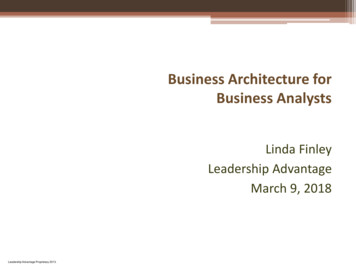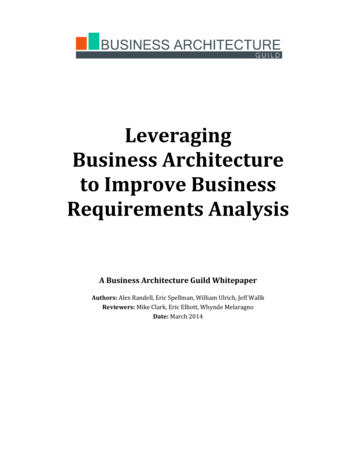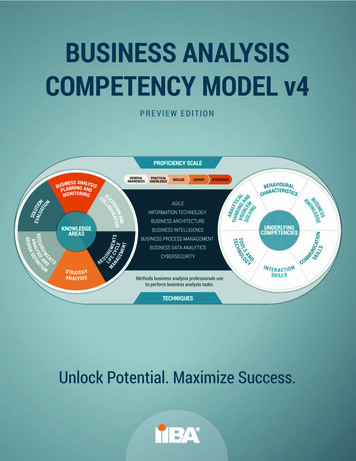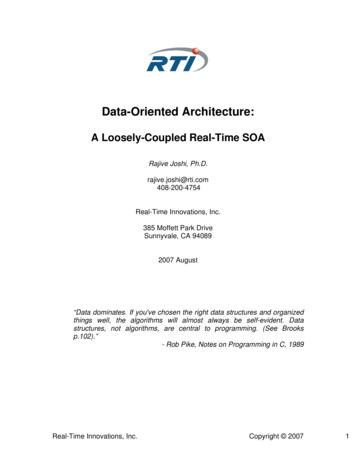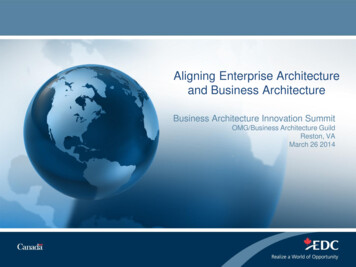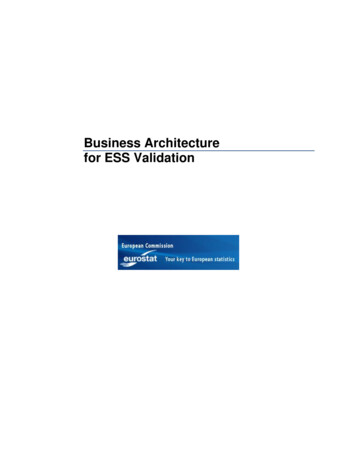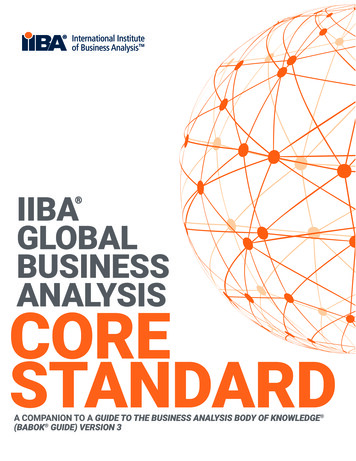
Transcription
BUSINESSARCHITECTURESPEAKER: CHRISTOPHER PETERSENPREPARED FOR IIBA NORTHEAST WISCONSIN NOVEMBER 2018
GUIDING PRINCIPLESBe Relatable: Personal experience isimportant but relatable content is mostimportant.Be Interesting: Introduction to businessarchitecture is important but building interest inbusiness architecture is most important.Be Applicable: Business architecture isimportant but business analysis is mostimportant.
Driver: Chapter community survey responded with high interest in business architecture topics.1Understanding ofBusiness ArchitectRole2BasicUnderstanding ofBusinessArchitecturePRESENTATION DRIVER / GOALS3Expose BusinessArchitectureTechniques
Presentation Goals/Chapter ValuesRoleBusiness ArchitectureTechniquesNetworkBe RelatableBe RelatablePersonalPerspectiveBe RelatableLearnBe InterestingBe InterestingNASAActivityBe InterestingDevelopBe ApplicableBe PerspectiveApplicableIIBABe ApplicablePRESENTATION / CHAPTER VALUES ALIGNMENT
UNDERSTANDINGBUSINESSARCHITECT ROLE Personal Perspective NASA Activity I IIBA Perspective
PERSONAL PERSPECTIVEZachmanFramework2001 – Fox Valley Technical College2005 – Lakeland CollegeUML – UseCase / sociate Degree in AppliedScience Majoring in ComputerInformation Systems Programmer /AnalystBachelor of Arts majoring inBusiness AdministrationConsultantCurious: Is there a better way?BusinessArchitect?Business AnalystSystems AnalystProgrammer/ AnalystAgile User IIBA NEWBoardGroup
STRATEGY - COMPLEXITYSTRATEGICConsultantEnterpriseBusiness AnalystOrganizational UnitsTeamLeaderTeamMemberTopDownTeamSystems yBusiness ArchitectureBottomsUpBusiness Architecture providesblueprints for business analysisto assess the organizationinterdependencies for impact,risk, and opportunities.Programmer/ AnalystSIMPLECOMPLEXTacticalBusiness Analysis
IIBA PERSPECTIVEThe goal of a business analyst working within the discipline ofbusiness architecture is to: understand the entire enterprise context and provide balanced insightinto all the elements and their relationship across the enterprise, and provide a holistic, understandable view of all the specialties within theorganization.To do this they require insight, skills, and knowledge from: business strategy and goals, conceptual business information, enterprise IT architecture, process architecture, and business performance and intelligence architecture.Source: x“There is one real difference Isee here: a business architectworks in the realm of strategy,and business systems analystsare engaged with tactics. I justcan’t see that as a sufficientlyprofound difference to call themdistinct fields of study.” — KevinBrennan, IIBARead more -businessanalyst-business-architect02045736
NASA ACTIVITY IObservatories in Hawaii have discovered life within our solarsystem. Not only life but a possible threat to man kind as an alienvessel appears to be headed to Earth. Estimated arrival 3 years.With no means of communication, hostile intent is unknown.Assemble your intergalactic team.Your mission: Establish communications with the Aliens1st Objective: Assess Current Capabilities – 1 minute2nd Objective: Identify Leader – 1 minute3rd Objective: Establish Roles and Responsibilities – 2 minutesReport to Ground Control – 1 minuteThis Photo byUnknownAuthor islicensed underCC BY
NASA ACTIVITY IIntergalactic TeamTeam LeadRadio OperatorData AnalystThreat AnalystLinguistMilitary AdvisorThis Photo byUnknownAuthor islicensed underCC BY
BASICUNDERSTANDINGOF BUSINESSARCHITECTURE Personal Perspective IIBA Perspective NASA Activity I1
FIRST APPLICATION: TOGAFThe Open Group Architecture Framework (TOGAF) isa framework for enterprise architecture that provides anapproach for designing, planning, implementing, andgoverning an enterprise information technologyarchitecture.[2]TOGAF is a high level approach to design. It istypically modeled at four levels: Business, Application, Data,and Technology. It relies heavily on modularization,standardization, and already existing, proven technologies ntFutureGapPhysicalCurrentFutureGapCopyright 2018 The Open Group. All Rights Reserved. TOGAF is a registered trademark of The Open Group
WHAT IS BUSINESSARCHITECTURE?Business Architecture Framework – Conceptual ModelWhy?Who?What?Where?When?How?How Well?Business Architecture – Logical Model
HOW - ARCHITECTURE DEVELOPMENT METHODHTTP://WWW.OPENGROUP.ORG/TOGAFFocus
BUSINESSARCHITECTURE
IIBA PERSPECTIVEBusiness Analysis OutcomesThe general outcomes of business architecture include: the alignment of the organization to its strategy, the planning of change in the execution of strategy, and ensuring that as change is implemented, it continues to align to the strategy.These business architecture outcomes provide context for requirements analysis, planning and prioritization, estimation, and high-levelsystem design. This provides insight and alignment with strategy, stakeholder needs, and business capabilities. Architectural views andblueprints provide information that may have otherwise been based on assumptions, and minimize the risk of duplication of efforts increating capabilities, systems, or information that already exist elsewhere in the enterprise.The various models and blueprints provided by business architecture are its key deliverables. These include, but are notlimited to: business capability maps, value stream maps, organization maps, business information concepts, high-level process architecture, and business motivation models.Source: x
HISTORY OF ENTERPRISE ARCHITECTURE NASA researched in early 2000s and documentedhistory of Enterprise Architecture as we know ittoday. “Improved efficiencies from our efforts enabledNASA’s overall IT spending to decrease by thirty sixpercent, to 1.4B, from 2005 to 2013, while NASA’smission portfolio evolved. “ – Larry Sweet IRM 2014 Source: https://www.nasa.gov/ocio/itsp 2014 IRMStrategic Plan
NASA ACTIVITY 1IA year has past and the Aliens have not changed course nor hailedyour signals. An observer through telescopic observation reporteda sighting of a Klingon ship un-cloaking and attacking the Aliens.The Aliens respond with overwhelming force and destroy theKlingon vessel. Continuing their journey towards Earth.Assemble your intergalactic team and formulate a strategy identifying goals,objectives and measures for success.This Photo byUnknownAuthor islicensed underCC BY
NASA ACTIVITY 1IDriversGoal 1Obj 1.1MeasureGoal 2Obj 2.1Obj 2.2MeasureA year has past and the Alienshave not changed course norhailed your signals. An observerthrough telescopic observationreported a sighting of a Klingonship un-cloaking and attacking theAliens.The Aliens respond withoverwhelming force and destroythe Klingon vessel. Continuingtheir journey towards Earth.Assemble your intergalactic team andformulate a strategy identifying goals,objectives and measures for success.
NASA LES/ATOMS/FILES/1PAGEITSTRATEGYFINAL2.PDF
LEARN BUSINESSARCHITECTURETECHNIQUES Personal Perspective NASA Activity I IIBA Perspective
MY MULTIPLE PERSPECTIVESThreatAnalysisEarthDefenseSystemSpace munication MethodThis Photo byUnknownAuthor islicensed underCC BY
MY MULTIPLE pace ForceSomeCapabilityCommunication MethodNoCapability
MY MULTIPLE PERSPECTIVESConceptual – Current State ViewInternal rnal ce
NASA ACTIVITY 111Conceptual – Current State ViewInternal rnal ceThe Alien attack is imminentwhen your communicationmanagement system has abreakthrough in capabilities.The aliens explain the Klingonsdestroyed their home planetsimilar to Earth and they are inneed of a new home. They arenot willing to live among us.Assemble your intergalactic teamand formulate a new strategy. Howdoes this change your outlook onyour capabilities chart? What isyour desired future state?
MY MULTIPLE PERSPECTIVESConceptual – Gap State ViewInternal OrganizationsCommunicationMethodSpace ForceExternal tDevelopingSpaceRefuelingServiceStableObsolete
MY MULTIPLE PERSPECTIVESConceptual – Future State ViewInternal OrganizationsExternal OrganizationsCommunicationMethodSpace erviceStableObsolete
IIBA PERSPECTIVEValue and Solutions DeliveredBusiness architecture provides a blueprint that management can use to plan and execute strategies from both informationtechnology (IT) and non-IT perspectives. Business architecture is used by organizations to guide: strategic planning, business remodelling, organization redesign, performance measurement and other transformation initiatives to improve customer retention, streamlining business operations, cost reduction, the formalization of institutional knowledge, and the creation of a vehicle for businesses to communicate and deploy their business vision.Source: x
Presentation Goals/Chapter ValuesRoleBusiness ArchitectureTechniquesNetworkBe RelatableBe RelatableBe RelatableLearnBe InterestingBe InterestingBe InterestingDevelopBe ApplicableBe ApplicableBe ApplicablePRESENTATION / CHAPTER VALUES ALIGNMENT
CHAPTERORGANIZATION
CHAPTER ORGANIZATIONCurrent State 2008VP FinanceVP StrategyVPAdministrationVP EventsPresidentVP Educationand CertificationVP Sponsorshipand MembershipVP Technology
CHAPTER ORGANIZATIONCurrent State 2010DirectorSponsorshipVP FinanceVP StrategyVPAdministrationVP EventsPresidentVP Educationand CertificationVP Sponsorshipand MembershipDirectorMembershipVP Technology
CHAPTER ORGANIZATIONCurrent State 2018 – Logical ViewDirector FinanceDirectorSponsorshipVP FinanceVP StrategyVPAdministrationVP EventsPresidentVP Educationand CertificationVP Sponsorshipand MembershipPresident ElectVP TechnologyDirectorMembershipDirectorTechnology
CHAPTER ORGANIZATIONCurrent State 2018 – Physical ViewOpenDirector FinanceOpenDirectorSponsorshipCheriVP FinanceOpenVP StrategyLynnVP EventsChrisPresidentShelbyVP Sponsorshipand MembershipDirectorMembershipJayElectionPresident ElectVPAdministrationVP Educationand CertificationBrianAngieTammyVP TechnologyDirectorTechnologyShawn
CHAPTERBUSINESSMODEL
THE ZACHMANFRAMEWORKFOR ENTERPRISEARCHITECTURE
BUSINESSARCHITECTUREWIKIPEDIA By Source (WP:NFCC#4), Fair use,https://en.wikipedia.org/w/index.php?curid 44857950
business strategy and goals, conceptual business information, enterprise IT architecture, process architecture, and business performance and intelligence architecture. "There is one real difference I see here: a business architect works in the realm of strategy, and business systems analysts are engaged with tactics. I just

